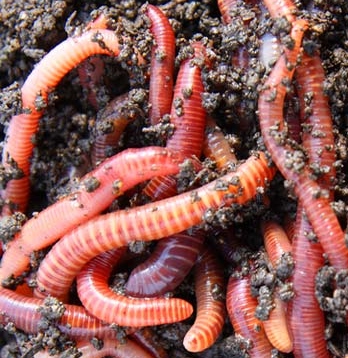Change Your Yard With Red Wigglers: Idea
Red wigglers are not just an inquisitiveness for compost enthusiasts; they are crucial representatives of transformation for any type of yard. By developing a standard worm bin and comprehending the nutritional requirements of these exceptional animals, gardeners can significantly boost dirt high quality and plant health. The process of converting organic waste right into rich, productive spreadings is both simple and rewarding. However, truth possibility of red wigglers goes past mere composting. Checking out the nuances of their treatment and the varied applications of their byproducts can unlock even greater advantages for your horticulture endeavors.

Benefits of Red Wigglers
Red wigglers, medically known as Eisenia fetida, are commonly hailed as nature's composting champions. These amazing worms offer a number of key advantages that can substantially enhance yard health and productivity.

(red wiggler worms for sale)Additionally, red wigglers freshen the dirt as they tunnel via it, developing networks that enhance water seepage and origin penetration. This oygenation reduces dirt compaction and promotes a flourishing community for helpful bacteria. Furthermore, their gastrointestinal processes produce worm castings, which are abundant in essential nutrients and advantageous germs that can improve dirt fertility.
One more noteworthy benefit of red wigglers is their capability to lower waste. By composting natural products that would or else add to garbage dump waste, they play a crucial role in lasting horticulture methods. Integrating these worms into your horticulture routine can lead to enhanced yields, healthier plants, and an extra vibrant yard environment, making them invaluable allies for garden enthusiasts seeking to improve their environmental footprint.
Establishing a Worm Container
Developing a worm container is an essential action for any person seeking to harness the advantages of red wigglers in their horticulture efforts. A suitable worm bin can be made from various products, including plastic containers, wood crates, or commercially readily available worm bins. The very first consideration is dimension; a bin that is at least 2 feet wide, 3 feet long, and 1 foot deep is typically optimal for a little to medium variety of worms.
Following, make sure proper water drainage and air flow. Drill holes in all-time low for excess wetness to escape and in the sides for airflow. It's important to create a bed linens layer, using materials such as shredded newspaper, cardboard, or coconut coir to offer a comfy atmosphere for the worms. The bedding must be damp but not soggy, looking like a wet sponge.
Place the bin in a location that maintains a constant temperature, ideally between 55 ° F and 77 ° F. Avoid direct sunshine or severe chilly, as these problems can hurt the worms. As soon as the container is established up, allow the bed linens to go for a couple of days before introducing the red wigglers, ensuring they have a thriving atmosphere in which to flourish.
Feeding Your Red Wigglers
Once the worm bin is established and the red wigglers are presented, appropriate feeding becomes crucial to keeping a healthy worm populace. Red wigglers grow on a varied diet plan, primarily consisting of kitchen area scraps and natural products.
When presenting food, slice the scraps right into smaller items to help with quicker intake. Furthermore, hide the food below a layer of bedding product to protect against top article fruit flies and other problems. Screen the feeding regularity; a basic policy is to give food every 1-2 weeks, depending upon the variety of worms and the quantity of food waste produced.

Collecting Worm Spreadings
How can you tell when it's time to collect worm spreadings from your container? The readiness of worm spreadings is indicated by a couple of vital indications. The product in the container ought to show up dark, crunchy, and abundant in appearance, resembling a fine soil. In addition, the original food scraps should be significantly damaged down or virtually indistinguishable, indicating that the worms have actually effectively processed them.
One more indicator is the reduction in worm task; as the spreadings accumulate, worms have a tendency to migrate towards fresher food resources. If you notice a decline in worm movement and the existence of castings at the end of the bin, it's a clear signal that harvesting is due.
To collect, gently scoop out the spreadings, taking care to decrease disturbance to the worms. A prominent technique entails dividing the spreadings utilizing light; worms tend to delve far from the light, permitting you to collect the castings more easily.
Gathering frequently, approximately every three to six months, makes sure a continual supply of this nutrient-rich amendment for your gardening endeavors. Remember, the top quality of your spreadings directly impacts the wellness of your plants.
Using Spreadings in Your Yard
To utilize worm castings effectively, mix them into the leading couple of inches of dirt prior to planting. This makes certain that nutrients are readily accessible to your plants. Alternatively, you can produce a nutrient-dense fluid fertilizer by steeping worm castings in water for a week, then applying the resulting "worm tea" directly to your plants. This approach not only provides instant nutrients yet likewise motivates healthy origin development.
Worm spreadings additionally enhance moisture retention within the dirt, minimizing the need for regular watering. Their natural pH equilibrium makes them appropriate for various plant kinds, from veggies to ornamentals. Regularly including worm castings right into your horticulture regimen can result in durable plant development, enhanced yields, and a general healthier garden ecosystem. Embrace the benefits of worm castings for a growing and sustainable yard.
Verdict
By establishing a worm bin, giving suitable food, and on a regular basis gathering nutrient-rich spreadings, garden enthusiasts can foster a sustainable ecosystem. The usage of worm spreadings and "worm tea" better contributes to moisture retention and nutrient availability in the dirt.
Comments on “Eco-friendly red worms: How to set up a worm farm”